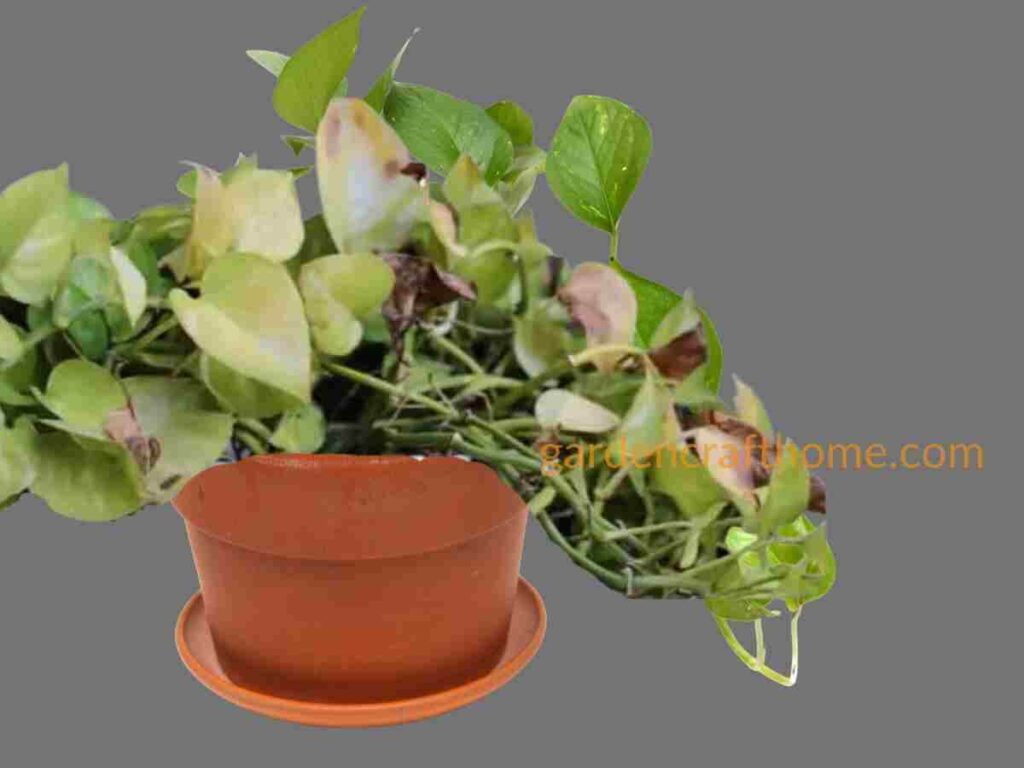How to care for Silver Pothos is all about providing basic needs such as fertilizer, water, light, etc.
Its needs are very similar to those of Epipremnum aureum. However, it is still worth examining them individually to best care for them.
Inside the post, you will find several links leading to in-depth Pothos information. Still, they are also valid in every way for Scindapsus.
In today’s post, I will explain Scindapsus pictus care and how to apply each care.
Now, let’s go straight.
What Is The Scindapsus Pictus Plant?
A Scindapsus pictus is a perennial rainforest plant from the Araceae family.
Other plants that belong to the Araceae family are epipremnum, anthurium, spathiphyllum, monstera deliciosa, and Adansonii.
Click here. If you want to learn how to care for Monstera deliciosa, [Link], or more on Adansonii, click here.
Despite being misnamed Silver Pothos, it falls under the Scindapsus genus.
In its natural habitat, this plant displays climbing behaviour by securing itself to tree trunks through aerial roots growing around the nodes.
Typically, we hang this plant at home, utilizing its elongated stems that can grow notably long.
How To Care For Silver Pothos [Scindapsus Pictus]
Silver Pothos has low-maintenance characteristics. To care for Scindapsus, only a proper supply of the following is necessary:
- Light
- temperature
- humidity
- fertilizer
- good watering routine
- Good soil
- Pruning
- Multiplication
- Repotting
Nevertheless, I will explain this in-depth in the following section of this post.
Since I mentioned light, I also say it can survive in a dark area. Let’s say it loves light, but it does well even when it’s not ideal.
It adapts very well to life at home, both from the point of view of temperatures and humidity.
During spring and summer, it loves to be outdoors, perhaps positioned in the shade of a tree or another place with plenty of diffused light.
The Achilles heel of Scindapsus is excess water. Watering must be abundant but well-spaced so as to allow the soil to dry completely, especially in winter.
Otherwise, it requires little attention; it should be lightly fertilized during the summer, repotted every two years in soft soil, and pruned when necessary.
In reality, silver phosphorus is not particularly demanding, even when it comes to soil. However, using one that is more draining than the universal one simplifies its care.
Temperature And Humidity
Maintaining the proper humidity and temperature can help you take care of silver Pothos.
The optimal temperature for silver pothos range is 22 to 28 degrees Celsius. Warm, humid temperatures are ideal for tropical plants.
During the night hour, the temperature drops to 13 to 15 degrees Celsius and is higher than 30 degrees Celsius.
In terms of growth rate and issue onset, the closer you are to the ideal range, the better.
When temperatures are low, the plant’s metabolism slows down, and the plant absorbs less water, increasing the risk of waterlogging in the soil and root rot.
On the contrary, when they are very high (>32 °C), the plant must be moved to the shade to slow down the dispersion of water from the pores.
The Ideal Environmental Humidity For Scindapsus Is 60–80 °C With Good Air Circulation; fortunately, the plant also tolerates drier conditions, with levels around 40–45 °C.
When humidity remains very low for extended periods (such as in winter when the heating is on), you may notice the edges of some daughters turning brown and dry.
Although this is not alarming, it indicates a slight state of dehydration, which can occur even when you have not watered for too long.
If possible, in spring, it is best to move the silver Pothos outside in the shade of a tree or under a porch. It has numerous benefits, such as wind, abundant light, and the presence of insects antagonistic to the most common parasites.
Just make sure not to place it in direct sunlight, especially in the first two weeks of transition or during the hottest hours.
When the minimum temperatures are around 15–17 °C, you need to bring the plant back indoors to prevent it from suffering damage from the cold.
Light
Properly is a way to care for Scindapsus pictus. To grow as best as possible.
Scindapsus should be placed in a well-lit place with lots of diffused light and possibly a few hours of direct sun in the first or last hours of the day.
The plant can grow discreetly even in low-light conditions, even if development is slowed down and part of the silvery variegation that distinguishes it is lost.
During the winter, when the sun’s rays are weak and the days are short, Scindapsus pictus can also be placed in full sun so as to keep its metabolism active and have continuous growth.
To prevent burning the leaves in late spring and summer, they should be shielded from the sun during noon, especially if left outdoors.
Watering
Providing water to the Scindapsus pictus is one way to maintain it; it is preferable to water it when the soil is dry.
To know more about watering a pothos plant, click here.
The plant suffers from water stagnation and shows symptoms such as yellow leaves, brown spots, and loss of turgor.
All these signs are often indicators of the presence of more or less marked root rot.
Too much water does not mean that it is excessively abundant but that it is too close together, not allowing the substrate to dry well.
Another case is where the soil is excellent and has too much water retention, retaining water for a very long time.
To understand if the substrate is dry, you must insert a finger or a wooden toothpick 4-5cm into the soil.
When you remove it, you will notice that when it is still wet, some particles remain attached, but if it is dry, your finger (or fingers) will be clean.
Or you can make your life easier with a soil moisture indicator [affpro]. You can water the plant with air conditioning, rain, demineralized water, or tap water.
Pothos is not very sensitive to the presence of limescale in the water. Still, I suggest that you keep the tap for at least 24 hours to dissolve the chlorine.
And if possible, filter it with one of these homemade jugs. [aff pro]
Repotting
Since repotting is a way to care for Scindapsus pictus, Repotting the silver pothos should be done on average every two years when the roots have colonized all the soil and have (almost) no more space to grow.
The ideal period is early spring, but it can also be done during the rest of the summer. It would help if you used a pot that is one or two sizes larger, not more.
Transferring it to a container that is too large is counterproductive because the excess substrate retains more water and increases the risk of rot.
In fact, Scindapsus pictus grows very well in a slightly narrow pot, which dries quickly and allows better oxygenation to the roots.
The plant does not require particularly sophisticated soil; you can get good results with good universal soil. I recommend adding 20–25% perlite to increase drainage and make it more airy.
Repotting all types of Pothos is the same. To learn how to repot your Pothos yourself, click here.
Fertilization
Proper fertilization is a way to care for silver Pothos. It is to ensure rapid growth and thick, large leaves.
The silver pothos must be fertilized every two waterings with nitrogen fertilizer throughout the growing season.
For an in-depth understanding of how to fertilize a pothos plant correctly, click here.
From April To September. I recommend administering half the dosage recommended on the label.
During autumn and winter, Scindapsus grows little and, therefore, needs to be fertilized less.
This may mean fertilizing once a month or continuing with the same frequency (every 2 waterings) but further reducing the concentration of the product.
The ideal fertilizer for Pothos is a fertilizer for Green Plants or a Slow-Release [aff pro] fertilizer like this one, which is complete and has a high nitrogen content.
The advantage of gradual release is that it is applied only once every 6 months, and the nutrients are released in a slow and balanced way throughout this period.
If you grow this plant in water, I recommend this fertilizer for hydroponics instead.
I have already discussed how I grow Pothos in water, and I also mentioned hydroponic fertilization. To learn more about hydroponic fertilizer, click here.
Propagation By Cuttings
To propagate Scindapsus pictus by cutting, use a sharp and sterilizes knife to cut the shoot into several sections
Each section of the cutting must have at least one node and one leaf, but it is better when you have 4-6 nodes and 3 leaves.
Both the roots and the new shoot will grow from the node. At the same time, the leaf serves to carry out the photosynthesis necessary to start its development.
The best time for propagation is the growing season, usually from April to September. Still, you can quickly tell by the presence of new leaves on the tips of the stems.
In short, when the plant shows signs of growth.
After cutting the cuttings, you need to root them. To do this, we can place them in water or a substrate of our choice, such as sphagnum moss, perlite, or simply in soil.
The entire procedure of pothos propagation is written in this post. I also explain the advantages and disadvantages of the three methods.
If you are interested in improving your knowledge of how to propagate your Pothos yourself, click here.
In most cases, we choose to take cuttings in water because it is more immediate and allows us to observe root development.
When the roots have grown sufficiently, you need to decide whether to continue growing the Pothos in water or whether to put them in a pot.
To copy my entire system on how I cultivate Pothos inside water, click here now.
In the latter case, it is necessary to keep the soil wet (not soaked) for the first two weeks so as to help the roots gradually adapt to the humidity level of the new medium.
After two weeks, the substrate is gradually allowed to dry more and more until it dries completely in about 30 days.
Staking Scindapsus Pictus
Supporting your silver pothos with the help of sake is a way to care for it, even though Scindapsis is sold as a drooping plant that has a climbing habit in nature.
Supporting a climbing plant with either bamboo or PVC poles is the same process for all house plans.
I have already written how to stake for Monstera; the process is the same for Pothos, so if you find it interesting, click here to read.
If we give them support, such as a mossy pole or a net, it is possible to make it grow upwards so that it can be used in other spaces of the house.
The advantage of moss poles is that, in some cases, they retain good moisture, which promotes root growth as the plant grows.
The roots, instead of remaining aerial, develop inside the support and contribute in all respects to water absorption.
Most of the moss poles that we find on the market are actually not made of moss (or, somewhat, sphagnum moss) but of a PVC tube covered with a layer of coarse coconut fibre.
As good as ready-to-use products are, they do not retain water and do not allow roots to grow inside. The plant must always be kept anchored; otherwise, it would fall on itself.
The ideal would be to make a moss pole at home, using sphagnum moss as a medium and rolling it inside a flexible plastic mesh.
Obviously, you will need to keep it moist and water it regularly. To learn how to grow sphagnum moss, click here. [Link]
Common Scindapsus Pictus Or Pothos Problems
Despite being a resilient and low-maintenance plant, Scindapsus pictus has a few issues that we may classify as persistent, such as:
Floppy Leaves:
In most cases, this problem is due to a water shortage caused by a delay in watering. Excessive heat or using tiny pots can speed up the process.
In this case, it is sufficient to wet the soil well to make the leaves regain firmness in a few hours.
The opposite problem can also cause the same symptom: too much water, which causes root rot and consequently prevents the roots from correctly absorbing it.
To learn more about Pothos, floppy leaves, and cures, click here [link].
Brown Spots:
There are several causes of dark patches on leaves, including low light, extreme heat, excessive or insufficient moisture, low humidity, and fungal issues.
Generally speaking, dry tips and margins of leaves result from dehydration and low humidity. Still, darker and larger necrotic areas are caused by cold, too much water, and illnesses.
Specifically, spots due to diseases often have a yellow halo. To learn more about the causes of Pothos having brown spots and their cure, click here
Stunted Growth:
The primary cause of silver pothos’s slow growth is insufficient light.
Even while it can also adapt to low light, growth slows down significantly or stops entirely at very low light levels.
Other reasons why the plant does not grow are the “almost total” lack of fertilizer in the soil or the use of a pot that is too small.
To learn more about the causes of Pothos, Stunted Growth, And Cures, Click Here.
Yellow Leaves:

In most cases, leaf yellowing is caused by too much water and consequent root asphyxiation or rot. Scindapsus soil must dry completely between waterings.
In addition, yellow leaves can also be caused by a lack of light, including in temperature drop, fungal parasites, or a lack of certain nutritional elements such as nitrogen, sulfur, or iron.
To learn more about the cause of Pothos Having Yellow Leaves And The Cure, Click Here [Link].
Quick Answer
How Much Light Does Scindapsus Pictus Need?
The ideal sunshine for a Scindapsus pictus is indirect light, ensuring the plant stays in a bright environment.
This plant can also endure low light circumstances, but that doesn’t imply you should keep it in a shaded environment.
They can only survive for some time in low-light conditions because there are resistant plants. Still, low-light areas are not the best environment for your silver pothos.
How Often Should I Water My Scindapsus Pictus?
We do not have any specific amount of water, so we recommend that you only apply water when the topsoil feels dry.
Ensure the pot you are using has proper drainage under to reduce waterlogging. Also, avoid compatible soil because it can also lead to waterlogging and root rot.
Where Do I Place My Silver Pothos?
Silver pothos may tolerate environments with medium to low light where the light source is further away. Still, it thrives in well-lit areas with brilliant direct or indirect sunshine.
Please keep it away from areas that get little to no natural light.
When Should I Repot My Scindapsus Pictus?
Repot your pothos plant every one to two years or when it starts to get root-bound and ensure that it is repotted in the spring.
What Type Of Soil Is Best For Scindapsus Pictus?
For all houseplants, we recommend using a well-draining potting mix soil that contains orchid bark and other ingredients like perlite and peat moss.
Can I Place My Scindapsus Pictus Outdoors?
Yes, you can place your Scindapsus pictus outdoors as it can survive sunlight and fluctuating temperatures, but if the temperature is too bad, send it inside to avoid damage.
What Pests Should I Watch Out For?
Spider mites, aphids, and mealybugs are the most common pests that might harm our Pothos plants.
to treat does infection use apply neem oil or Insecticidal soap right away.
How Do I Increase Humidity For My Scindapsus Pictus?
- The simplest and most practiced way to increase humidity for our plant is by misting the leaves and using a humidity tray with water and pebbles.
- Another option is to place a room humidifier nearby, which can increase humidity levels.
Conclusion
Now that you know how to care for Scindapsus pictus, it is essential to maintain proper fertilization, sunlight, watering, and good soil.
The simplest way to understand this caring process is to give your plants attention and provide for their needs when needed.
Avoid overfertilization, overwatering, or direct sunlight in the hopes of making them stay healthy overnight or grow faster.
I will advise you to reduce a quarter of the fertilizer measurement listed on the manufacturer’s label instead of adding too much.
Remember, prevention is better than cure. Feel free to navigate through our website for more information concerning other plants such as Monstera, bonsai, etc.





